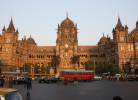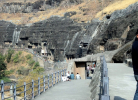
History of Mumbai City
The name ‘Mumbai’ was derived by the colloquial pronunciation of a local protective deity, Goddess MumbaDevi. Mumbai is not one region, to begin with. It is a combination of seven different islands on the Arabian Sea namely, Bombay Island, Mazagaon Island, Colaba Island, Parel Island, Worli Island, Old Woman’s Island and Mahim Island.
Pre-Historic Era
There are no details about who ruled these regions for the first time. However, we have evidence in the Kandivali region of Mumbai that this region was inhabited since the Stone Age of South Asia. Before 3rdBC, the region was occupied by small fishing communities of Koli.
Mauryan Era
In the 3rd century BC, these seven islands along with a huge area of mainland India came under the control of Emperor Ashoka, a famous Buddhist ruler of the country. It was during his time when the caves of Kanheri were excavated. There are literature indications about this region in Greek literature. This region was called as Heptanesia in ancient Greek. Mahakali caves were also built during the Maurya Empire of Ashoka.
After the demise of the king, his reign did not stay long under the Maurya Empire. During 2nd BC, the reign came under the control of many dynasties like Rashtrakutas, Abhira, Satavahanas, Kalachuris, and others before falling into the Silahara Dynasty.
Portuguese Era
Silahara Dynasty ruled the region from the 8th century to the 13th century. Many monuments including Elephanta Caves, Jogeshwari Caves, and others were built during this reign. They were out-numbered by the strong Kingdom of Gujarat, who ruled the seven islands along with many regions of Gujarat for around two centuries from mid of the 14th century to the mid of 16th century.
In the mid of 16th century, Portuguese took over the islands and many parts of Gujarat from the Bahadur Shah, who ruled Gujarat during the time of Portugal invasion. It was under the control of Portuguese until 1661.
During a royal political marriage between Catherine de Braganza of Portugal and Charles II of Britain, the regions of these seven islands were given to Britain as dowry. Charles leased out his area to the then-successful East India Company and it was named Bombay and the name stuck for a very long time, even after independence.
British Rule
Bombay was a large port area allowing the British to perform trade and other businesses with ease. Thus, The East India Company shifted its headquarters to Bombay from Surat.
In the mid 19th century, Bombay came under the direct control of the Queen and stayed so until independence.Thus started the flourishing time for Bombay. Later, after the Suez Canal opening, Bombay became a world-wide known area.
Post-Independence
It remained under British until Independence and the last troops of Britain walked out of the Gateway of India, as a symbol of leaving the control in the country.
At the beginning of the 1960s, Bombay started to bloom into an industrial giant and became the capital of Maharashtra. It was later named Mumbai and it is still growing as we speak.






















